Introduction
Within This Page
The laboratory module is the key unit in any lab facility. When designed correctly, a lab module fully coordinates all architectural and engineering systems. A well-designed modular plan provides the following benefits:
Flexibility. The lab module should encourage change within the building. Research is changing all the time, and buildings must allow for reasonable change. Many private research companies make physical changes to an average of 25 percent of their labs each year. Academic institutions typically change the layout of 5 to 10 percent of their labs annually.
Expansion. Lab planning modules allow the building to adapt easily to expansions or contractions without sacrificing facility functionality.
Description
Basic Lab Module
Most laboratory modules are 10'6" wide, but they vary in depth from 20' to 33', depending on the lab requirements and the cost-effectiveness of the structural system. The 10'6" dimension is based on two rows of casework and equipment (each row 2'6" deep) on each wall, a 5' aisle, and 6" for the wall thickness separating one lab from another. If there is an exterior brick module, a 10'8" module may be called for, and an 11' module may be needed if there are several pieces of 3'-deep equipment, high-performance fume hoods or biosafety cabinets. The additional 4" for each module is an important issue. A building with 30,000 gross square feet for a single floor plate can fit one more lab module across the depth of the building if 10'8" modules are used instead of 11'. The additional module depth equates to over 150 linear feet of additional bench space, which could accommodate many research teams. The 5' aisle width is a minimum because of Americans with Disabilities Act requirements and to allow one researcher to pass another without interference. All walls between labs should be 6" thick, whether they are built during initial construction or added later.
If the lab module is too wide, there will be too much circulation area and not enough space for casework and equipment. If the lab module is too narrow, then either the aisle will be too narrow, creating an unsafe research environment, or there will be room for casework on one wall only. If the laboratory building design is not based on a lab module, then the initial and long-term operational costs will be higher because of less efficient construction.
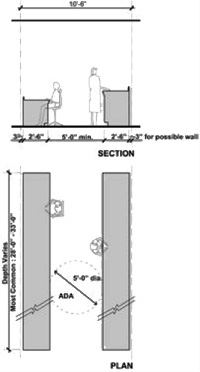
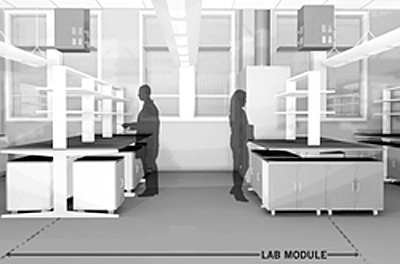
Plan and section of a typical lab module.
The typical lab module is shown here three dimensionally with casework and circulation in the an actual lab.
Two-Directional Module
Flexibility increases if a lab module works in two directions. Employing the common width of 10'6" and a depth of either 21' (2 modules at 10'6") or 31'6" (3 modules at 10'6") allows casework to be organized in either direction. This concept is more user-friendly than the basic lab module concept, but it may require more space.
A two-directional grid allows varied lengths of run for casework, which, if movable, can be rearranged to create various workstation types and sizes based on research needs. Utility drops, if necessary, should occur at the intersection of the 10'6" modules.
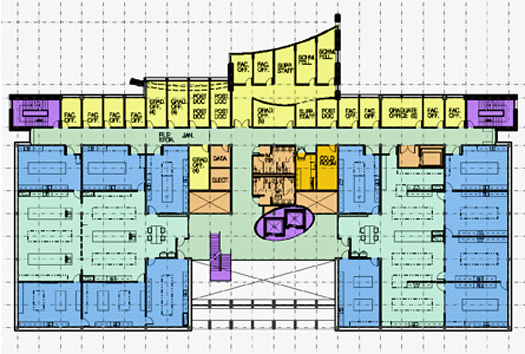
When the lab module is organized to work for both orientations, the laboratories are much more flexible than with a one-directional module.
Three-Dimensional Lab Module
A three-dimensional lab module combines the basic lab module or a two-directional lab module with any lab corridor arrangement for each floor of a building. This means that a three-dimensional lab module can have a single-corridor arrangement on one floor, a two-corridor layout on another, and so on. A three-dimensional lab module involves the following requirements:
- A basic or two-directional lab module must be defined.
- All vertical risers must be fully coordinated (vertical risers include fire stairs, elevators, restrooms and shafts for utilities).
- The mechanical, electrical and plumbing systems must be coordinated in the ceiling to work with the multiple-corridor arrangements.
Focusing on a building three-dimensionally allows the designer to be more responsive to the program needs of the researchers on each floor. A 3D design allows the corridor arrangement on any floor to be easily changed, facilitating renovations. This approach is highly recommended for most facilities, but it requires much more thought and coordination in the initial design.
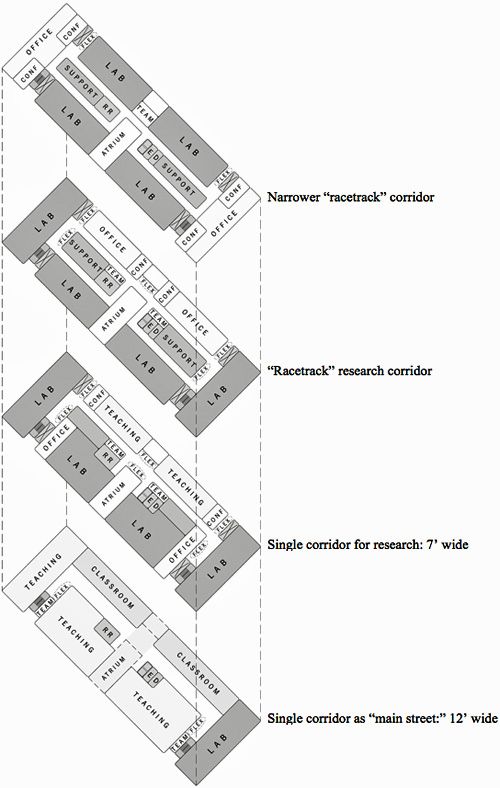
The floor plans illustrate that multiple corridor arrangements can be provided on different floors to support a variety of programs and allow the building to be even more flexible.
Today's laboratories must be designed to be able to change overnight, largely by the researchers themselves. At the CDC National Center for Environmental Health, the laboratories are highly flexible.
"The new flexible, state-of-the-art laboratory space allows our scientists to work in a multitude of unique micro environments tailored to support their particular research program." —Eric J. Sampson Ph.D, Director, Division of Laboratory Sciences, CDC
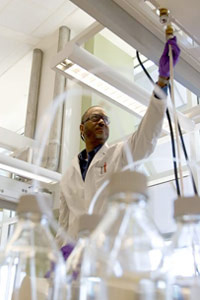
The researcher can easily and safely connect or reconnect instruments to the overhead service carrier.
The overhead service carriers are the "heart" of the CDC laboratories, pumping life for efficient and flexible functioning. To achieve free floor space, all utilities and services are available from the ceiling and wall.
The exterior zones of the building, which are more equipment-intensive, have overhead service carriers on a modular basis. The interior zones have vertical service drops able to serve a wide surface area on the floor.
The CDC overhead service carriers were designed using a Unistrut™ kit, with structural members forming the framework. This is a more cost-effective and flexible approach than pre-manufactured service carriers and allows for easy modifications and additions throughout the life of the building. It also allowed the design team to create custom design that corresponds with the aesthetic appeal of the building.
But most unique is that the service carriers allow a gypsum wall to be added or removed without having to tear down the carrier or drop. This allows retrofit within a couple of days!
The carriers have integrated snorkel exhausts with connections that drop down from the ceiling in the interior zone. Outrigger lights are also integrated.
For added flexibility, the service carriers and drops have the capacity for two additional high-purity gases to be plumbed from the interstitial above. "Blank" quick-connect fittings are provided to connect the gases when needed.
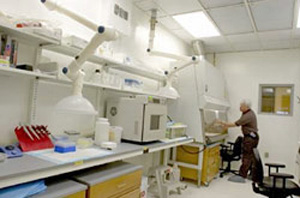
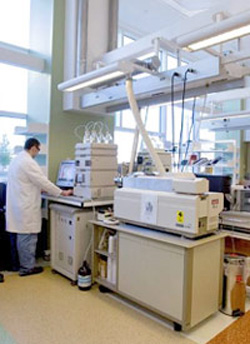
Wall utility drop and ceiling-mounted articulated snorkel.
Services from the interstitial floor above drop down into the service carriers throughout modular openings in the slab.
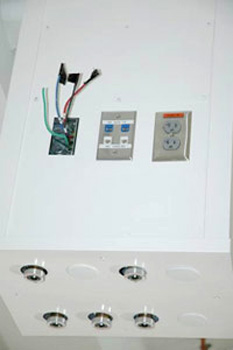
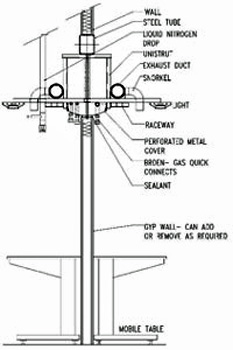
Ceiling utility drop with quick connects and blanks for future gases.
Detail of an overhead service carrier showing how a gypsum wall could be added or removed, as required.
The design of the CDC's National Center of Environmental Health laboratory provides many benefits:
- An alcove design that is isolated from path of travel, giving a high degree of safety. This alcove becomes a self-sufficient research space with bench space, a hood and a sink.
- Allows a modular systems approach.
- Maintains a pleasing systematic look as opposed to random locations of containment devices.
- Gives guidance to researchers for placement of future fume hoods or biosafety cabinets.
- Interstitial and mechanical systems can accommodate up to 50 percent more additional hoods. Additional sleeves in the interstitial post-tension slabs are located in a modular pattern and can be tapped into for future exhaust connections.
- Reduces long-term operational costs associated with retrofits.
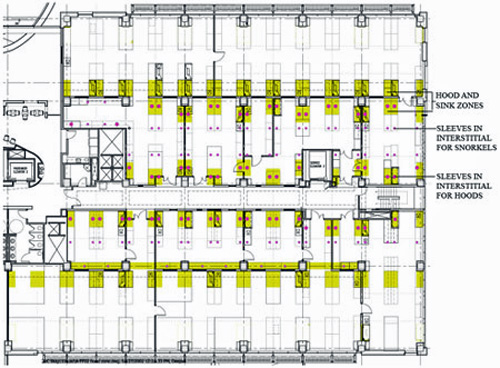
Diagram of modular approach to lab hood and sink zone.
Another unique feature of the CDC project was that the structural columns, which typically form vertical obstructions in a space, were made functional for the labs. The columns are furred out, and wiring and plumbing is stacked vertically. Cold and hot water connections and an acid-waste drain stubout are provided at every wet column, allowing flexibility to add sinks in the future. Temperature-sensitive equipment is cooled by chilled water supply and return. In addition, two quadruplex 120 V receptacles and two data receptacles provide power to wiremold under the mobile tables when needed.
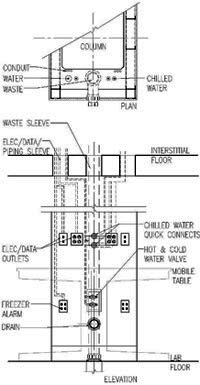
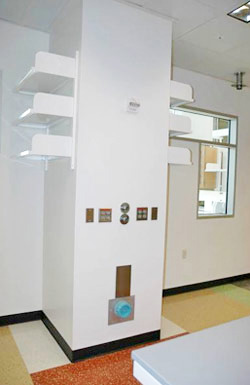
Detail showing wires, process piping and plumbing that can be incorporated as a part of the wet column.
Wet column with a variety of utility connections.
Movable Tables and Mobile Base Cabinets
To allow for equipment and casework to be set up as per the researcher's needs and to allow for quick change in the lab set up, the only fixed casework is associated with fume hoods, ducted biological safety and cabinets, and sinks. The rest of the casework is comprised of movable tables and mobile base cabinets, allowing an unlimited range of configurations. Overhead shelving and cabinets can be removed or relocated, providing a full working surface for taller pieces of equipment when needed. The movable tables can be adjusted vertically from 28" to 36", allowing a sit-down or stand-up position.
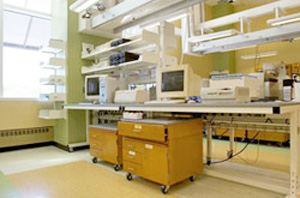
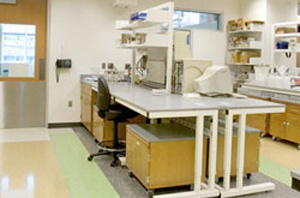
Mobile base cabinets with "add-a-drawer" option to maximize space under tables.
Mobile lab benches with option to add or remove shelving to accommodate larger table-top instrumentation.
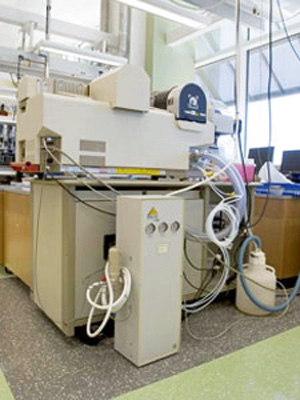
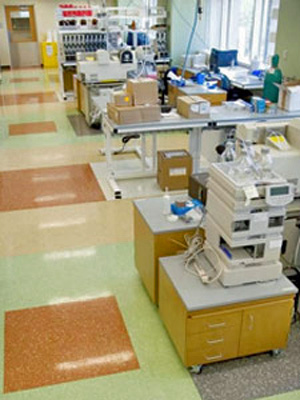
Equipment zones (initially empty) within labs allows researchers to add casework or equipment as needed.
Zones designated with flooring patterns as placement guides help maintain safe aisle widths.
Additional Resources
Federal Agencies
- Department of Energy (DOE), Office of Environment, Health, Safety & Security
- For examples of facilities to support instruments of science, see DOE's Brookhaven National Laboratory
- Department of Veterans Affairs, Office of Construction & Facilities Management
- Environmental Protection Agency, Office of Administration and Resources Management
- General Services Administration, Office of Design and Construction: Office of the Chief Architect
- National Aeronautics and Space Administration, Facilities and Real Estate Division
- National Institutes of Health, Office of Research Facilities, Development and Operations developed the NIH Design Policy and Guidelines to provide standards to assist planners, architects, and engineers in designing biomedical and animal research facilities for the NIH.
Organizations/Associations
- Laboratories for the 21st Century (Labs21)—Sponsored by the U.S. Environmental Protection Agency and the U.S. Department of Energy, Labs21 is a voluntary program dedicated to improving the environmental performance of U.S. laboratories.
- A Design Guide for Energy-Efficient Research Laboratories—A reference that helps facility owners, managers, and designers apply energy-efficiency features in laboratories.
- Environmental Performance Criteria (EPC)—The Labs21 Environmental Performance Criteria is a rating system specifically designed for laboratory facilities. It builds on the U.S. Green Building Council's LEED® Green Building Rating System.
- Labs21 Design Process Manual—Includes a "quick reference" sustainable strategies checklist as well as links to key resources for each stage of the design process.
- Labs21 Tool Kit
- Labs21 Annual Conference Presentations Archive
- U.S. Green Building Council's LEED®—Because research facilities present a unique challenge for energy efficiency and sustainable design, the USGBC formed the LEED-AGL Committee to develop a guide that helps project teams apply LEED credits in the design and construction of laboratory facilities.
Publications
- ASHRAE 110 Method of Testing Performance of Laboratory Fume Hoods
- ASHRAE Handbook
- ASHRAE Laboratory Design Guide
- Biosafety in Microbiological and Biomedical Laboratories (BMBL) 5th Edition by U.S. Department of Health and Human Services, Centers for Disease Control and Prevention and National Institutes of Health. Washington, DC: U.S. Government Printing Office, December 2009.
- Building Type Basics for Research Laboratories, 2nd Edition by Daniel Watch. New York: John Wiley & Sons, Inc., 2008. ISBN# 978-0470163337.
- Guidelines for Planning and Design of Biomedical Research Laboratory Facilities by The American Institute of Architects, Center for Advanced Technology Facilities Design. Washington, D.C.: The American Institute of Architects, 1999.
- R&D Magazine—Provides information on a variety of topics related to laboratories. The R&D Lab of the Year award is presented annually to outstanding laboratory facilities throughout the United States.
Others
- Building Research Information Knowledgebase (BRIK)—an interactive portal offering online access to peer-reviewed research projects and case studies in all facets of building, from predesign, design, and construction through occupancy and reuse.










